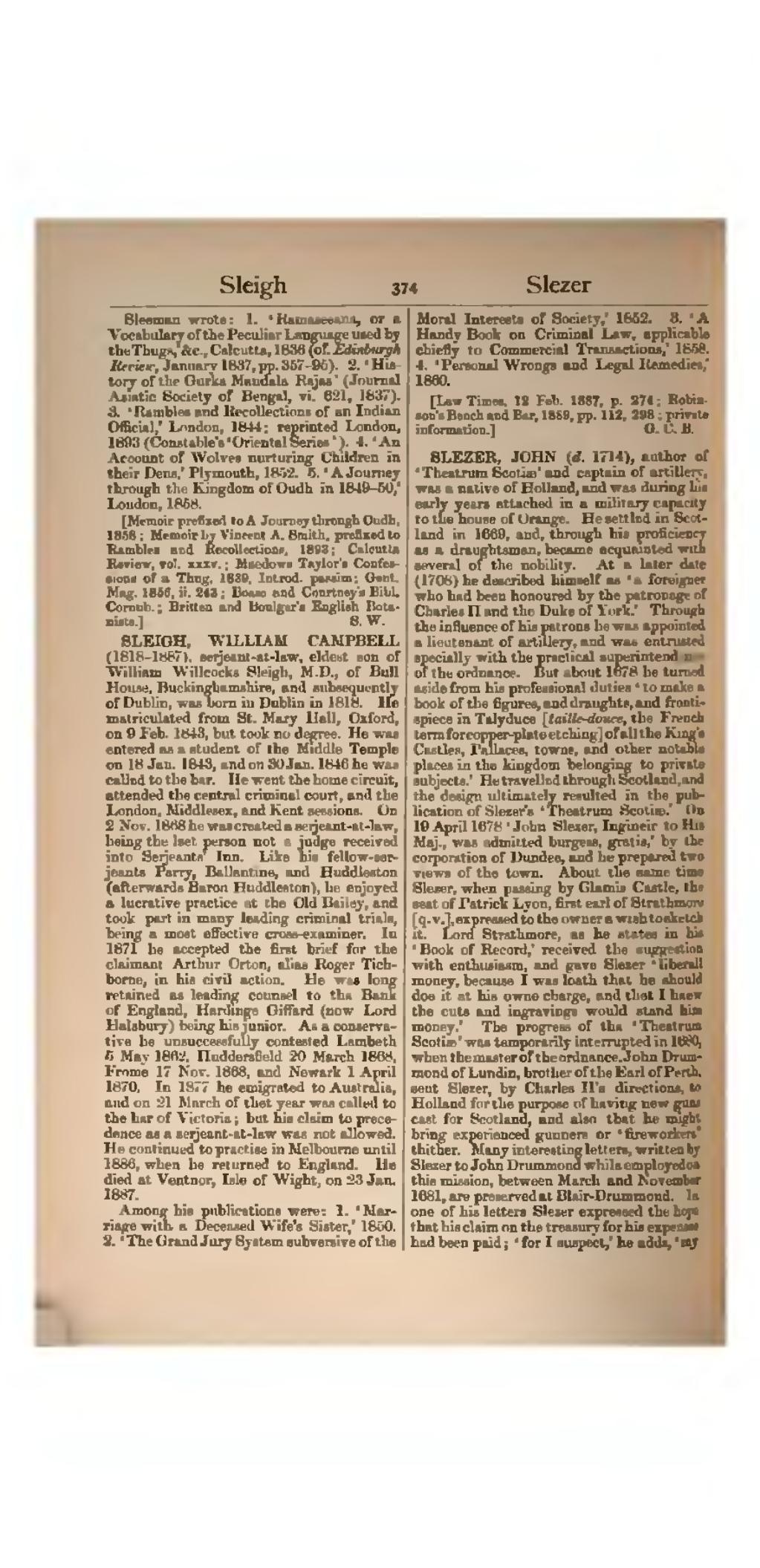Sleeman wrote:
- ‘Ramaseeana, or a Vocabulary of the Peculiar Language used by the Thugs,’ &c., Calcutta, 1836 (cf. Edinburgh Review, January 1837, pp. 357–95).
- ‘History of the Gurka Mandala Rajas’ (Journal Asiatic Society of Bengal, vi. 621, 1837).
- ‘Rambles and Recollections of an Indian Official,’ London, 1844; reprinted London, 1893 (Constable's ‘Oriental Series’).
- ‘An Account of Wolves nurturing Children in their Dens,’ Plymouth, 1852.
- ‘A Journey through the Kingdom of Oudh in 1849–50,’ London, 1858.
[Memoir prefixed to A Journey through Oudh, 1858; Memoir by Vincent A. Smith, prefixed to Rambles and Recollections, 1893; Calcutta Review, vol. xxxv.; Meadows Taylor's Confessions of a Thug, 1839, Introd. passim; Gent. Mag. 1856, ii. 243; Boase and Courtney's Bibl. Cornub.; Britten and Boulger's English Botanists.]
SLEIGH, WILLIAM CAMPBELL (1818–1887), serjeant-at-law, eldest son of William Willcocks Sleigh, M.D., of Bull House, Buckinghamshire, and subsequently of Dublin, was born in Dublin in 1818. He matriculated from St. Mary Hall, Oxford, on 9 Feb. 1843, but took no degree. He was entered as a student of the Middle Temple on 18 Jan. 1843, and on 30 Jan. 1846 he was called to the bar. He went the home circuit, attended the central criminal court, and the London, Middlesex, and Kent sessions. On 2 Nov. 1868 he was created a serjeant-at-law, being the last person not a judge received into Serjeants' Inn. Like his fellow-serjeants Parry, Ballantine, and Huddleston (afterwards Baron Huddleston), he enjoyed a lucrative practice at the Old Bailey, and took part in many leading criminal trials, being a most effective cross-examiner. In 1871 he accepted the first brief for the claimant Arthur Orton, alias Roger Tichborne, in his civil action. He was long retained as leading counsel to the Bank of England, Hardinge Giffard (now Lord Halsbury) being his junior. As a conservative he unsuccessfully contested Lambeth 5 May 1862, Huddersfield 20 March 1868, Frome 17 Nov. 1868, and Newark 1 April 1870. In 1877 he emigrated to Australia, and on 21 March of that year was called to the bar of Victoria; but his claim to precedence as a serjeant-at-law was not allowed. He continued to practise in Melbourne until 1886, when he returned to England. He died at Ventnor, Isle of Wight, on 23 Jan. 1887.
Among his publications were:
- ‘Marriage with a Deceased Wife's Sister,’ 1850.
- ‘The Grand Jury System subversive of the Moral Interests of Society,’ 1852.
- ‘A Handy Book on Criminal Law, applicable chiefly to Commercial Transactions,’ 1858.
- ‘Personal Wrongs and Legal Remedies,’ 1860.
[Law Times, 12 Feb. 1887, p. 274; Robinson's Bench and Bar, 1889, pp. 112, 298; private information.]
SLEZER, JOHN (d. 1714), author of ‘Theatrum Scotiæ’ and captain of artillery, was a native of Holland, and was during his early years attached in a military capacity to the house of Orange. He settled in Scotland in 1669, and, through his proficiency as a draughtsman, became acquainted with several of the nobility. At a later date (1708) he described himself as ‘a foreigner who had been honoured by the patronage of Charles II and the Duke of York.’ Through the influence of his patrons he was appointed a lieutenant of artillery, and was entrusted specially with the practical superintendence of the ordnance. But about 1678 he turned aside from his professional duties ‘to make a book of the figures, and draughts, and frontispiece in Talyduce [taille-douce, the French term for copper-plate etching] of all the King's Castles, Pallaces, towns, and other notable places in the kingdom belonging to private subjects.’ He travelled through Scotland, and the design ultimately resulted in the publication of Slezer's ‘Theatrum Scotiæ.’ On 19 April 1678 ‘John Slezer, Ingineir to His Maj., was admitted burgess, gratis,’ by the corporation of Dundee, and he prepared two views of the town. About the same time Slezer, when passing by Glamis Castle, the seat of Patrick Lyon, first earl of Strathmore [q. v.], expressed to the owner a wish to sketch it. Lord Strathmore, as he states in his ‘Book of Record,’ received the suggestion with enthusiasm, and gave Slezer ‘liberall money, because I was loath that he should doe it at his owne charge, and that I knew the cuts and ingravings would stand him money.’ The progress of the ‘Theatrum Scotiæ’ was temporarily interrupted in 1680, when the master of the ordnance, John Drummond of Lundin, brother of the Earl of Perth, sent Slezer, by Charles II's directions, to Holland for the purpose of having new guns cast for Scotland, and also that he might bring experienced gunners or ‘fireworkers’ thither. Many interesting letters, written by Slezer to John Drummond while employed on this mission, between March and November 1681, are preserved at Blair-Drummond. In one of his letters Slezer expressed the hope that his claim on the treasury for his expenses had been paid; ‘for I suspect,’ he adds, ‘my
